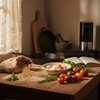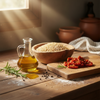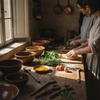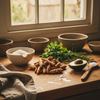3/4 Measuring Cup: The Home Chefs Precision Guide
Key Takeaways
- Precision in measuring ingredients is crucial for successful cooking and baking.
- The 3/4 measuring cup plays a vital role in achieving accurate measurements.
- Using the correct measuring tools can prevent common kitchen mishaps.
- Small measurement errors can significantly affect the outcome of recipes.
- Reliable measuring cups contribute to consistent and delicious results.
Table of Contents
Ever watched a soufflé collapse because of one mismeasured ingredient? Or had cookies spread into pancake disasters? Every memorable meal starts with precision, and the humble 3/4 measuring cup is often the unsung hero that separates kitchen chaos from culinary triumph. 4-piece 18/8 stainless steel measuring cup sets ensure you always have this essential size on hand for perfect results.
This specific measurement appears in countless recipes, from scaling down batch cookies to perfecting sauce ratios. Yet many measuring sets skip this crucial size, leaving home chefs scrambling with mathematical gymnastics mid-recipe. Whether you're tackling a daunting new technique or perfecting your signature dish, understanding how to nail the 3/4 cup measurement transforms good intentions into great results. Comprehensive measuring cup and spoon sets can save time and eliminate guesswork in the kitchen.
Here's everything you need to master this essential measurement: exact conversions, pro techniques, material comparisons, and why the right tools make all the difference in your culinary creativity. For more on the importance of accuracy, see this guide to accurate stainless steel measuring cups.
What Is a 3/4 Measuring Cup & Why Precision Matters
Defining the 3/4 Cup
A 3/4 measuring cup holds exactly 177.44 milliliters, 12 tablespoons, or 6 fluid ounces. To visualize: it's three-quarters the volume of a standard cup, or one and a half times a 1/2 cup measure. This seemingly odd size appears frequently in recipes because it represents perfect scaling ratios for many culinary formulas.
Why Kitchen Precision Matters
Baking is chemistry, off by even 10% on flour or liquid, and your bread won't rise properly, cookies will spread incorrectly, or sauces will break. The 3/4 cup measurement often appears in hydration ratios for doughs (where water-to-flour percentages determine texture) and in sauce reductions where precise volumes create the right consistency. Professional kitchens rely on exact measurements because reproducible results require mathematical precision, not guesswork.
Is 3/4 Cup Standard in Measuring Sets?
Many basic measuring sets omit the 3/4 cup, including only 1 cup, 1/2 cup, 1/3 cup, and 1/4 cup sizes. This forces cooks into time-consuming workarounds, combining multiple smaller measures or eyeballing portions. Professional-grade sets include this size because serious home chefs need efficiency and accuracy, especially when scaling recipes or working with time-sensitive preparations. For a full selection, browse measuring cups designed for both home cooks and professionals.
| Measurement | Milliliters | Tablespoons | Fluid Ounces |
|---|---|---|---|
| 3/4 Cup | 177.44 ml | 12 tbsp | 6 fl oz |
| 1/2 Cup | 118.29 ml | 8 tbsp | 4 fl oz |
| 1 Cup | 236.59 ml | 16 tbsp | 8 fl oz |
Types of Measuring Cups & Why Choice Matters

Dry vs Liquid Measuring Cups: The Right Tool for Each Job
Dry measuring cups have flat rims for leveling ingredients like flour and sugar, while liquid measuring cups feature spouts and space above the measurement line to prevent spills. Using a dry cup for liquids can result in 10-15% measurement errors because you can't read the meniscus properly. For sticky ingredients like honey or peanut butter, dry cups work better because you can scrape them clean completely. For more details, read our article on liquid measuring cups.
Material Matters: Silicone, Stainless Steel, Glass, Plastic
Pro-grade silicone measuring cups, like those from DI ORO, offer unique advantages: they're heat-resistant to 600°F, forever-chemical-free, and LFGB certified for food safety. Unlike plastic cups that can harbor bacteria in scratches or warp over time, silicone maintains its shape and remains non-reactive. Stainless steel provides durability but can dent, while glass offers clarity but breaks easily. DI ORO's seamless design with stainless steel core combines the best of both worlds, flexibility with structural integrity. If you want to learn more about the pros and cons of different materials, check out our post on metal measuring cups.
Why Complete Sets Include 3/4 Cup
Professional measuring sets include "odd" sizes like 3/4 cup because they eliminate recipe math and reduce prep time. When doubling a recipe that calls for 3/8 cup of an ingredient, you need 3/4 cup, having the right tool means one scoop instead of measuring 1/2 cup plus 1/4 cup. This efficiency matters when you're managing multiple recipe components simultaneously. For a versatile option, consider the 4-piece 18/8 stainless steel measuring spoon set for precise small measurements.
How To Use a 3/4 Measuring Cup Like a Pro
Proper Measuring Techniques
For dry ingredients: overfill the cup, then level with a straight edge like a knife back. For liquids: place the cup on a flat surface, pour to the line, and read at eye level. For sticky ingredients like peanut butter, coat the cup lightly with oil first, the ingredient will release cleanly without waste. Always measure within your set for best results. If you’re looking to upgrade your kitchen, explore bundles & sets that include all the essentials for accurate measuring.
For more inspiration on essential kitchen tools, browse our award winning kitchen utensils collection.
For additional tips on measuring and baking, you can also visit this comprehensive guide on Serious Eats.
Frequently Asked Questions
Why is using a 3/4 measuring cup important for achieving precise cooking and baking results?
The 3/4 measuring cup allows for exact ingredient portions that many recipes call for, ensuring balanced flavors and proper texture. Precision in measuring prevents common kitchen mishaps, turning good intentions into consistent, delicious results.
What are the differences between dry and liquid measuring cups, and when should each type be used?
Dry measuring cups are designed to be filled to the top and leveled off for ingredients like flour or sugar, while liquid measuring cups have a spout and measurement markings for easy pouring of liquids. Use dry cups for solid ingredients and liquid cups for wet ingredients to ensure accuracy.
Why do many basic measuring cup sets omit the 3/4 cup size, and how does having this size improve kitchen efficiency?
Many basic sets skip the 3/4 cup to simplify the collection, but this forces home chefs to do math or combine smaller measures mid-recipe. Having a dedicated 3/4 cup saves time, reduces guesswork, and improves precision, especially for scaling recipes or perfecting sauces.
How can small measurement errors, such as those avoided by using a 3/4 measuring cup, impact the outcome of recipes?
Even minor measurement mistakes can cause baked goods to rise improperly, sauces to break, or cookies to spread too thin. Using the correct 3/4 measuring cup helps maintain the exact ratios needed for texture and flavor, turning potential kitchen chaos into culinary triumph.




